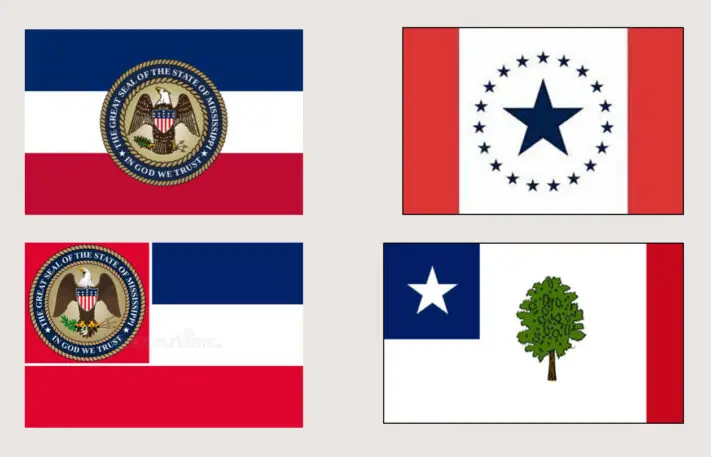But in an historic first for the state and historic last for the country, Mississippi Governor Tate Reeves signed a bill into law on Tuesday that not only removes that battle emblem from its flag, but retires the flag completely.
The bill to redesign the flag is long overdue step forward. But it has already broken a cardinal rule of flag design, according to the North American Vexillological Association (NAVA): it mandates that the new flag include the words “In God We Trust.” The issue isn’t the phrase itself but that the bill requires lettering on the flag at all. There’s another peculiarity about the bill, too, according to NAVA secretary Ted Kaye: it’s one of just two states to put the final design to a popular vote.

The Mississippi bill calls for a nine-member committee to be appointed by July 15. The committee will hold meetings and take public comment, consult with experts, and recommend a new design for the flag by September 14. Should a majority of people vote against the redesign, it’s back to the drawing board, and a new version will be put up to a vote in 2021.
When it comes to flag design, any vexillologist (ie., flag designer) will tell you there are a few best practices to keep in mind. In fact, NAVA published a booklet on the subject in 2006 called Good Flag, Bad Flag: How to Design a Great Flag. As outlined by Kaye, who authored the book, there are five basic principles to follow: keep it simple; use meaningful symbolism; use two to three basic, high contrast colors; avoid lettering or seals; and be distinctive.
So why will lettering keep Mississippi from having, as Kaye says, a “great” flag? Text is detrimental to the core function of a flag: to be read and understood at a distance. Not to mention that flags are in constant motion, and the design needs to be reversible and understood on both sides. “Those issues generally aren’t placed on logos,” says Kaye. “A flag is a special form of logo that has a specific use.” And it shouldn’t require the crutch of text. “Writing doesn’t belong on flags. Flags are graphic symbols, not verbal symbols.” Kaye says he has mailed 50 copies of the booklet to a NAVA member currently in conversation with legislators and prospective members of the forthcoming commission for guidance on the design process otherwise.

And he does have some other recommendations for the committee to consider. “Understand the basic principles of flag design,” says Kaye. “Then they should look at what the great state flags look like.” The states that ranked highest in a 2001 NAVA survey include Texas, New Mexico, Alaska, Maryland, and Arizona. All use two to three high contrast colors and simple designs. None use text. Kaye also recommends turning to the state’s own history for inspiration.
But history and symbolism are hotly debated topics in Mississippi, especially when supporters of the flag say it’s a part of their “heritage.” That claim is muddied by the fact that the Confederate emblem on Mississippi’s state flag—which has saturated popular culture since southern Dixiecrats used it at a 1948 convention—was never the official flag of the confederacy. The Confederate flag we know today became a popular symbol well after the Civil War, often as a reaction to Black people gaining civil rights. States like Florida and Alabama designed their flags after Reconstruction as Jim Crow laws emerged in the South, while Georgia added the Confederate emblem to its flag in 1956, following school integration two years earlier.
“Based on its association with the Dixiecrats, it was at least in part, if not entirely, a symbol of resistance to federally enforced integration. Undoubtedly, too, it acquired a racist aspect from its use by the Ku Klux Klan, whose violent activities increased during this period,” according to a Georgia state senate document. Georgia’s current flag was adopted in 2003.
Even though Mississippi is the last state to remove the design of the confederate battle flag from its modern iteration, there are five other state flags that arguably recall Confederate symbols, according to Kaye: Alabama, Arkansas, Florida, Georgia, and North Carolina. For his part, Kaye recommends Mississippi take inspiration from the Stennis Flag, an inversion of the pre-Confederate Bonnie Blue Flag, or the Magnolia Flag, which was used by the state between 1861 and 1865, but not by the Confederacy. A third option? Start from scratch. “This is Mississippi’s opportunity to pursue a great design,” says Kaye. “This is a turning point for Mississippi in what symbols it will use to represent itself and its citizens.”
Recognize your brand’s excellence by applying to this year’s Brands That Matter Awards before the early-rate deadline, May 3.
